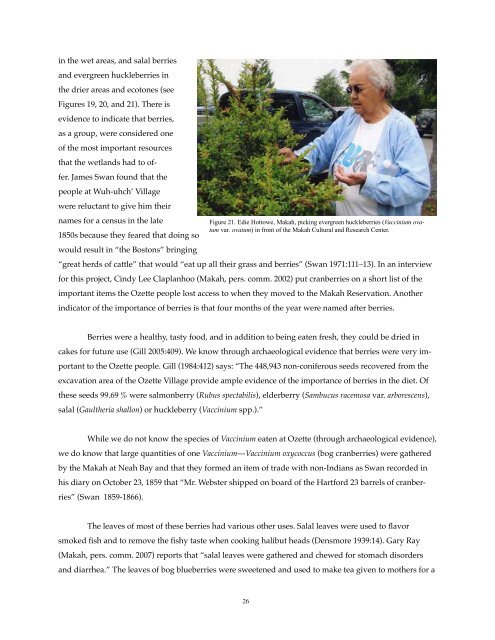The Ozette Prairies of Olympic National Park - Natural Resources ...
The Ozette Prairies of Olympic National Park - Natural Resources ...
The Ozette Prairies of Olympic National Park - Natural Resources ...
Create successful ePaper yourself
Turn your PDF publications into a flip-book with our unique Google optimized e-Paper software.
in the wet areas, and salal berries<br />
and evergreen huckleberries in<br />
the drier areas and ecotones (see<br />
Figures 19, 20, and 21). <strong>The</strong>re is<br />
evidence to indicate that berries,<br />
as a group, were considered one<br />
<strong>of</strong> the most important resources<br />
that the wetlands had to <strong>of</strong>fer.<br />
James Swan found that the<br />
people at Wuh-uhch’ Village<br />
were reluctant to give him their<br />
names for a census in the late<br />
Figure 21. Edie Hottowe, Makah, picking evergreen huckleberries (Vaccinium ovatum<br />
var. ovatum) in front <strong>of</strong> the Makah Cultural and Research Center.<br />
1850s because they feared that doing so<br />
would result in “the Bostons” bringing<br />
“great herds <strong>of</strong> cattle” that would “eat up all their grass and berries” (Swan 1971:111–13). In an interview<br />
for this project, Cindy Lee Claplanhoo (Makah, pers. comm. 2002) put cranberries on a short list <strong>of</strong> the<br />
important items the <strong>Ozette</strong> people lost access to when they moved to the Makah Reservation. Another<br />
indicator <strong>of</strong> the importance <strong>of</strong> berries is that four months <strong>of</strong> the year were named after berries.<br />
Berries were a healthy, tasty food, and in addition to being eaten fresh, they could be dried in<br />
cakes for future use (Gill 2005:409). We know through archaeological evidence that berries were very important<br />
to the <strong>Ozette</strong> people. Gill (1984:412) says: “<strong>The</strong> 448,943 non-coniferous seeds recovered from the<br />
excavation area <strong>of</strong> the <strong>Ozette</strong> Village provide ample evidence <strong>of</strong> the importance <strong>of</strong> berries in the diet. Of<br />
these seeds 99.69 % were salmonberry (Rubus spectabilis), elderberry (Sambucus racemosa var. arborescens),<br />
salal (Gaultheria shallon) or huckleberry (Vaccinium spp.).”<br />
While we do not know the species <strong>of</strong> Vaccinium eaten at <strong>Ozette</strong> (through archaeological evidence),<br />
we do know that large quantities <strong>of</strong> one Vaccinium---Vaccinium oxycoccus (bog cranberries) were gathered<br />
by the Makah at Neah Bay and that they formed an item <strong>of</strong> trade with non-Indians as Swan recorded in<br />
his diary on October 23, 1859 that “Mr. Webster shipped on board <strong>of</strong> the Hartford 23 barrels <strong>of</strong> cranberries”<br />
(Swan 1859-1866).<br />
<strong>The</strong> leaves <strong>of</strong> most <strong>of</strong> these berries had various other uses. Salal leaves were used to flavor<br />
smoked fish and to remove the fishy taste when cooking halibut heads (Densmore 1939:14). Gary Ray<br />
(Makah, pers. comm. 2007) reports that “salal leaves were gathered and chewed for stomach disorders<br />
and diarrhea.” <strong>The</strong> leaves <strong>of</strong> bog blueberries were sweetened and used to make tea given to mothers for a<br />
26
















